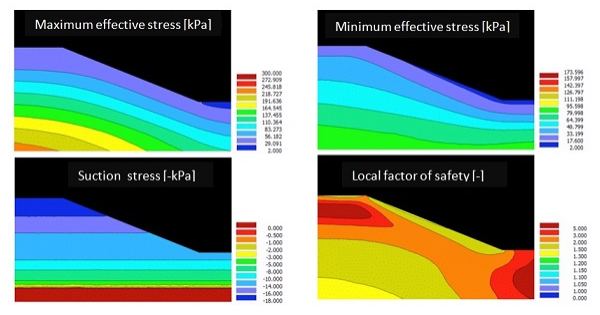The Slope Cube (Slope Stress and Stability) module was developed by the Soil Water Retention, LLC as a supplemental module of the HYDRUS (2D) software package to simulate two-dimensional transient fields of soil moisture, soil suction, suction stress, total and effective stresses, and local factor of safety. While the SLOPE Stability module is based on classical, and engineering soil mechanics theories, and uses the effective stress approach only for saturated conditions, a new add-on module "SLOPE Cube" (Slope Stress and Stability), recently developed in cooperation with Dr. Ning Lu from the Colorado School of Mines, uses a unified effective stress approach for both saturated and unsaturated conditions (Lu et al., 2010). The module is intended to predict spatially and temporally infiltration-induced landslide initiation and to carry out the slope stability analysis under variably-saturated soil conditions. Transient moisture and suction fields are directly obtained using the HYDRUS-2D model, and are used to compute the effective stress field in hillslopes (Lu and Godt, 2013). Furthermore, instead of the methodology of one factor safety for the entire slope in the classical slope stability analysis, the SLOPE Cube module computes the field of factor of safety in the entire domain within hillslopes (Lu et al., 2012), allowing identification of the development of potential failure surface zone or surface.

Illustration of the physical processes in the SLOPE Cube module
Slope Cube is a physically based hydro-mechanical framework focusing on assessment and prediction of the initiation and locations of landslide occurrences under rainfall conditions. Slope Cube couples variably-saturated flow and stress fields to simulate transient hillslope hydrologic and mechanical responses to rainfall events. Two recent advancements are implemented in Slope Cube that are beyond the traditional physically based landslide models. The first is the utilization of the suction stress-based effective stress to unify the description of effective stress distribution in hillslopes under variably-saturated conditions. The second is to employ a recently established concept of the local factor of safety to capture evolution of stress paths toward the failure state in hillslopes.

Lu, N., Wayllace, A., and Formetta, G. The Slope Stress and Stability (Slope Cube) Module for HYDRUS (2D): Simulating Slope Stress and Stability in Variably-Saturated Soils, Version 1.0, PC Progress, Prague, Czech Republic, 52 pp., 2016.
References
Lu, N., J. W. Godt, and D. Wu, A closed-form equation for effective stress in variably saturated soil, Water Resources Research, 46, doi:10.1029/2009WR008646, 2010.
Lu, N., B. Sener, A. Wayllace, and J. W. Godt, Analysis of rainfall-induced slope instability using a field of local factor of safety, Water Resources Research, 48, W09524, doi:10.1029/2012WR011830, 2012.
Lu, N., and J. W. Godt, Hillslope Hydrology and Stability, Cambridge University Press, 2013.